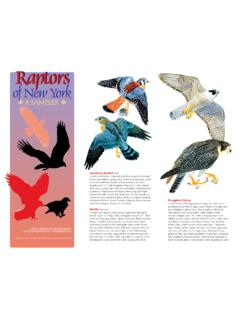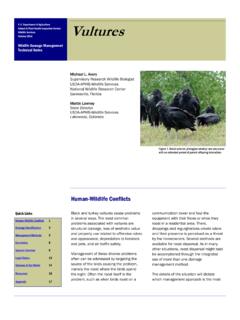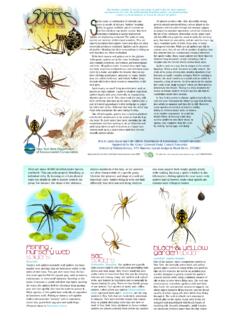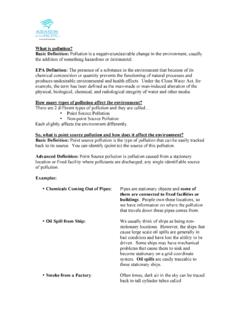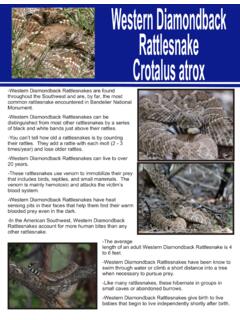Transcription of A Guide to Missouri's Snakes
1 A Guide TO missouri SSNAKESMISSOURI DEPARTMENT OF CONSERVATIONA Guide to missouri s Snakesby Jeffrey T. Briggler, herpetologist, and Tom R. Johnson, retired herpetologist, missouri Department of ConservationPhotographs by Jeffrey T. Briggler, Richard Daniel, Tom R. Johnson, and Jim RathertEdited by Larry ArcherDesign by Susan FerberFront cover: Eastern milksnake. Photo by Jim 2017 by the Conservation Commission of the State of MissouriPublished by the missouri Department of ConservationPO Box 180, Jefferson City, missouri 65102 0180 Equal opportunity to participate in and benefit from programs of the missouri Depart-ment of Conservation is available to all individuals without regard to their race, color, religion, national origin, sex, ancestry, age, sexual orientation, veteran status, or disability. Questions should be directed to the Department of Conser-vation, PO Box 180, Jefferson City, MO 65102, 573-751-4115 (voice) or 800-735-2966 (TTY), or to Chief, Public Civil Rights, Office of Civil Rights, Department of the Interior, 1849 C Street, NW, Washington, TO KNOW missouri S SNAKESS nakes have generated more fear and misunderstanding than any other group of animals.
2 Psychologists have proven that a fear of Snakes (called ophidiophobia) is acquired; we are not born with it. Once people learn some of the interesting facts about Snakes and discover that most of them are harmless and beneficial, their aversion may diminish. With patience and understanding, almost anyone can overcome a dread of Snakes and actually enjoy studying them. One thing is certain even people with a well-developed fear of Snakes are curious about , with its wide variety of wildlife habitats prairies, Ozark hills and valleys, swamps, marshes has 49 species and subspecies of Snakes (a subspecies is a geographic race of a species). Most of our Snakes are harmless. Although many may bite in self-defense, their bites usually produce nothing more than harmless scratches. There are only six species of venomous Snakes in all of missouri , and they are described in a separate section of this are members of the Class Reptilia, a group that also includes turtles, alligators, crocodiles, and lizards.
3 Snakes and lizards are similar in many ways, but there are some import-ant differences. A clear, non-movable scale covers the eyes of all Snakes , whereas most lizards have move-able eyelids. Most lizards have legs, but some are legless. The slender glass lizard, which lives nearly statewide in missouri , is an example; it looks like a snake because it has no legs, but like all our lizards, the slender glass lizard has moveable eyelids and external ear openings, both of which are lacking in Snakes . In addition, lizards have a pair of lungs, while most Snakes have an elongated right lung and either no left lung or only a rudimentary Snakes are legless, they are able to move about with ease. A snake s backbone has from 200 to 400 vertebrae, depending on the 4species, which permits extreme flexibility. Snakes move forward by a side-to-side movement, or in a straight line using muscles that are anchored to the ribs and attached to skin, allowing forward movement.
4 Sometimes this movement is described as walking on their ribs. All Snakes can must swallow their food whole, and some can engulf animals three times the diameter of the snake s head. The lower jaws of Snakes are loosely joined to the skull and the upper jaws are moveable. A snake grasps its prey (fish, frog, mouse) by the head and engulfs it by advancing first one side of the jaw and then the other. The snake s teeth also help it swallow. The teeth are sharp and curve toward the rear of the mouth. They hold the prey and prevent its escape. Some Snakes , such as watersnakes and garter- Snakes , eat their prey alive, while venomous Snakes usually inject venom into the animal and swallow it after it is dead. Several missouri Snakes , such as ratsnakes, kingsnakes, milksnakes, and bullsnakes, kill by constriction. The snake grasps the prey in its mouth and immedi-ately wraps several tight coils around it. It was once believed that constriction prevented the prey from breathing, and it would die from lack of oxygen.
5 However, recent research shows that constriction stops blood flow and causes heart failure in prey . Then the snake swallows its bullsnake eating a snake s long, forked, extendable tongue is often thought to be dangerous; in fact, it is completely harm-less. Snakes and lizards use their tongues to An Eastern gartersnake picks up a scent with its R. JOHNSONNOPPODOL PAOTHONG5pick up odors that are transferred to special sense organs (Jacobson s organ) in the roof of the food habits of missouri s Snakes are as varied as the types of Snakes we have. Some, such as the rough greensnake, eat insects and insect larvae. Others, like watersnakes, eat fish, frogs, tadpoles, or crayfish. The western ratsnake and bullsnake eat rodents, small birds, and small bird eggs. Kingsnakes also eat rodents and are important predators of lizards and other Snakes , including venomous Snakes shed their outer layer of skin periodic s usually shed once every four or five weeks during warm months, whereas adults may shed once every six or eight weeks during their active season.
6 In the case of rattlesnakes, a new segment is added at the base of the rattle at each shedding. In missouri , rattlesnakes may shed from two to five times a year, depending on their growth rate. As the rattle becomes longer, the old segments weaken and may break off, so it is not possible to determine the age of a rattlesnake by counting the segments in the Prairie kingsnake shedding its missouri , Snakes normally breed in the spring, soon after they emerge from winter dormancy. Studies show, however, that a few species may breed in the fall. About half of missouri s snake species lay eggs; the rest give birth to fully developed of the egg-laying Snakes include western ratsnakes, bullsnakes, kingsnakes, racers, wormsnakes, ring-A rough greensnake emerges from its R. JOHNSONTOM R. JOHNSON6necked Snakes , and rough greensnakes. The size of the egg depends on the species; the number of eggs produced depends on the size of the female.
7 The larger the female, the more eggs she can produce. Snake eggs are elongated and have a tough, leathery shell. Females select rotten logs or stumps, leaf litter or sawdust piles in which to deposit their eggs. As a young snake develops within the egg, a small egg tooth grows on the tip of its snout; the snake uses this tooth to slit the shell when hatching. Afterwards, the tooth is shed. Snakes usually hatch in late summer or early of the Snakes that retain their young until they are completely developed are watersnakes, gartersnakes, brownsnakes, copperheads, cottonmouths, and rattlesnakes. This form of reproduc-tion is slightly advanced over egg layers. The young Snakes are retained and protected inside the female during their devel-opment. Each young snake is protected inside a thin, sac-like membrane contain-ing yolk for nourishment. Some of the young Snakes break through the membrane while inside the female and emerge from the female in a tight coil; others break through after being born.
8 Snakes that develop inside the female are normally born in mid to late smallest snake native to missouri is the flat-headed snake (Tantilla gracilis), which averages from 7 to 8 inches (18 20 cm) long. The larg-est is the bullsnake (Pituophis catenifer sayi), which can grow to over 6 diamond-backed watersnakes emerging from their sac-like R. JOHNSON7 SPECIES ACCOUNTSNon-venomous SnakesFor more details, visit WormsnakeCarphophis vermisAbout: This species is never seen in the open; it either hides under rocks, logs, or boards, or burrows into damp soil or leaf litter. Wormsnakes mainly live on wooded : This species is usually purplish-brown above and salmon pink on the belly and lower sides. The tail has an interesting (and harmless) spike, which also helps it maneuver through : Ranges from 7 to 11 inches (18 28 cm).Diet: Earthworms, and insect larvae and Distribution:Statewide, except for extreme southeastern corner and a few counties in the north-central part of the R.
9 JOHNSON9 Northern ScarletsnakeRare SpeciesTOM R. JOHNSONC emophora coccinea copeiAbout: One of missouri s most brilliantly colored Snakes , the northern scarletsnake is extremely rare to find. This secretive snake spends much of its life underground, surfacing primarily to feed. It is named for the red or crimson blotches along the : It is similar in pattern and color to the Eastern milksnake, but instead has a red or orange snout and a spotless, white : Ranges from 14 to 20 inches (36 51 cm).Diet: Eggs of other reptiles, and occasionally rodents, lizards, and small Distribution: Scattered counties in south-central and southern parts of the s SnakeRare SpeciesJEFFREY T. BRIGGLERC lonophis kirtlandiiAbout: This small, hard to find, and poorly known species occurs in only a few Midwestern states. The Kirtland s snake uses mainly crayfish burrows in grassland habitats that are damp and adjacent to a river, creek, or wetland.
10 Due to loss of native grasslands, this species is extremely rare in the : Reddish brown with two rows of dark spots along each side and a pink to red belly with a row of black spots on each : Ranges from 14 to 18 inches (36 46 cm).Diet: Earthworms and slugs, and occasionally crayfish and small Distribution: Restricted to a few counties along the Mississippi River in the northeast corner of the Yellow-bellied RacerColuber constrictor flaviventrisAbout: Also known as the blue racer, the eastern yellow-bellied racer prefers bushy fields, grasslands, and open woods. This species is active by day and will take shelter under rocks, brush, or in animal burrows if pursued. As the name implies, racers can move fast, especially through tall grass or brush. As with many of our harmless Snakes , a racer will sometimes vibrate its tail when : The color of this common snake is variable from olive, tan, brown, or blue to nearly black.










